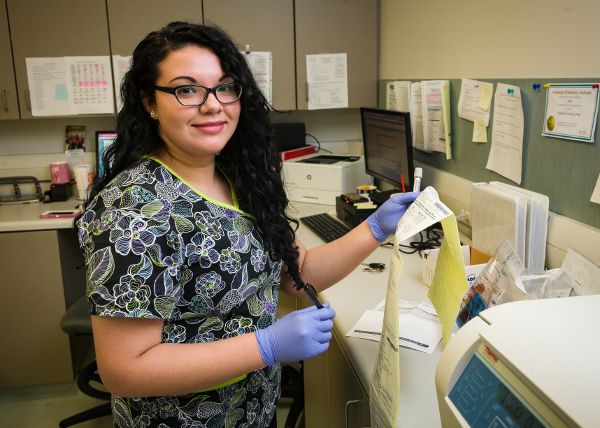Overview
Liver cancer begins when cells in the liver start to grow uncontrollably. A tumor can form when more cancer cells develop, and it can spread to other areas of the body. As it grows and spreads, the cancer becomes more advanced.
The liver is situated below the right lung under the ribs. The liver metabolizes and stores nutrients, creates clotting factors to prevent excess bleeding, secretes bile for the intestines to break down certain nutrients, and processes toxins (including alcohol and other intoxicants) into waste products excreted via urine and stool.
Types of liver cancer include:
- Hepatocellular carcinoma or hepatocellular cancer
- Intrahepatic cholangiocarcinoma or bile duct cancer
- Angiosarcoma and hemangiosarcoma
- Hepatoblastoma
- Metastatic or secondary liver cancer, originating elsewhere in the body and spread to the liver (secondary liver cancers are more common in the United States than primary liver cancers)
Symptoms
Early liver cancers may not cause symptoms, but symptoms may include:
- Loss of appetite
- Unintended weight loss
- Feeling of fullness after small meals
- Nausea or vomiting
- A mass under the ribs on the right or left side, caused by an enlarged liver or spleen
- Abdominal pain or pain near the right shoulder blade
- Abdominal swelling or fluid build-up
- Itching
- Jaundice (yellowing of the skin and eyes)
It is important to note that the symptoms above can be caused by a number of other non-cancerous causes, but it is important to be checked by a medical professional to improve the chances of effective treatment.
Risk Factors
The risk factor most commonly associated with liver cancer is chronic hepatitis B or C infection (also known as Hep-B and Hep-C or HBV and HCV). HBV/HCV is bloodborne, which means it can be spread via contaminated needles, unprotected intercourse, blood transfusions (very rarely in the US), and childbirth. Hepatitis B is more likely to cause symptoms but is usually successfully treated within months; hepatitis C is less likely to cause symptoms and, without detection and treatment, may lead to chronic infection. Chronic HBV/HCV infection can lead to cirrhosis, in which damaged liver cells are replaced by scar tissue.
Most cases of liver cancer co-occur with evidence of cirrhosis, and other causes of cirrhosis also increase a person’s risk of liver cancer, including alcohol abuse, non-alcoholic fatty liver disease, primary biliary cirrhosis, and inherited metabolic diseases. Obesity increases the risk of liver cancer, which is likely because it may result in fatty liver disease. Type 2 diabetes also increases the risk of liver cancer, particularly in patients with co-occurring risk factors like alcohol abuse, chronic hepatitis, or obesity.
Long-term exposure to aflatoxins from fungal contamination of certain foods increases the risk of developing liver cancer, though exposure is rare in developed countries like the US in which the aflatoxin content of food is tested and regulated. Vinyl chloride and thorium dioxide/Thorotrast exposure and schistosomiasis parasite infection are similarly rare risk factors. The long-term use of anabolic steroids (not cortisone steroids like prednisone or hydrocortisone) may slightly increase the liver cancer risk. Persistent exposure to arsenic, often via contaminated drinking water, may be a risk factor of concern in certain areas of the US.
Men are more likely than women to develop liver cancer. Increased smoking rates and other secondary factors may partially explain this difference. Asian-Americans and Pacific Islanders have higher rates of liver cancer than those from other racial/ethnic backgrounds in the United States.
Smoking increases the risk of liver cancer; quitting can reduce risk, but people who have never smoked are at lowest risk.
Certain conditions can increase the risk of developing liver cancer:
- Tyrosinemia
- Alpha1-antitrypsin deficiency
- Porphyria cutanea tarda
- Glycogen storage diseases
- Wilson disease
Prevention
While some risk factors, such as gender, hereditary conditions, and race cannot be controlled, many cases of liver cancer can be prevented by following the guidelines below to reduce risk:
- Avoid or treat hepatitis infection.
- Limit alcohol consumption.
- Refrain from or stop smoking.
- Maintain a healthy weight.
- Limit exposure to carcinogenic substances including aflatoxins and arsenic.
- Treat inherited diseases associated with a higher risk of liver cancer as early as possible.
Diagnosis
If there is a suspicion of liver cancer, a detailed medical history and physical exam will be performed. Your doctor will ask questions about your risk factors and family history. The physical exam will include an examination of your abdomen, skin, and eyes (to check for jaundice), and may include additional lab testing.
Imaging tests including Ultrasound, CT, MRI, and X-ray angiography may be used for diagnosis and throughout treatment. Laparoscopy or biopsy are sometimes used to confirm a diagnosis of liver cancer, but may not be necessary based on the results of imaging tests.
Other tests, including blood tests, may be used in addition to the diagnostic tools discussed above.
Treatment
The treatment plan will depend on the stage of the cancer, as well as other factors. Our doctors will work closely with you and your family determine the best treatment plan for you. Options for treatment could include:
- Surgery
- Ablation
- Embolization
- Radiation therapy
- Targeted therapy
- Immunotherapy
- Chemotherapy
Your doctor may decide more than one of these treatment options will be in your best interest. Surgery is necessary for most cases of liver cancer.







